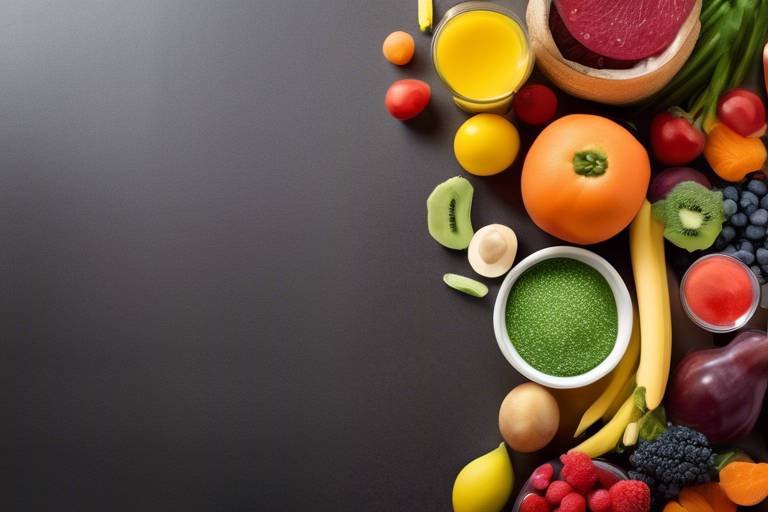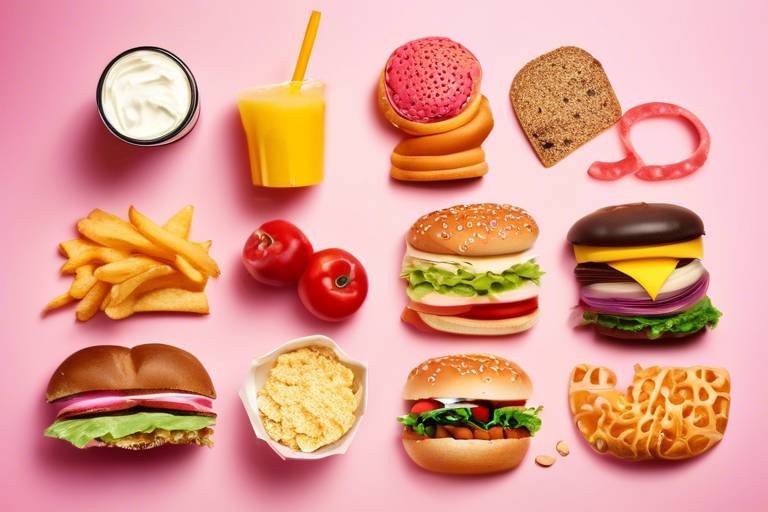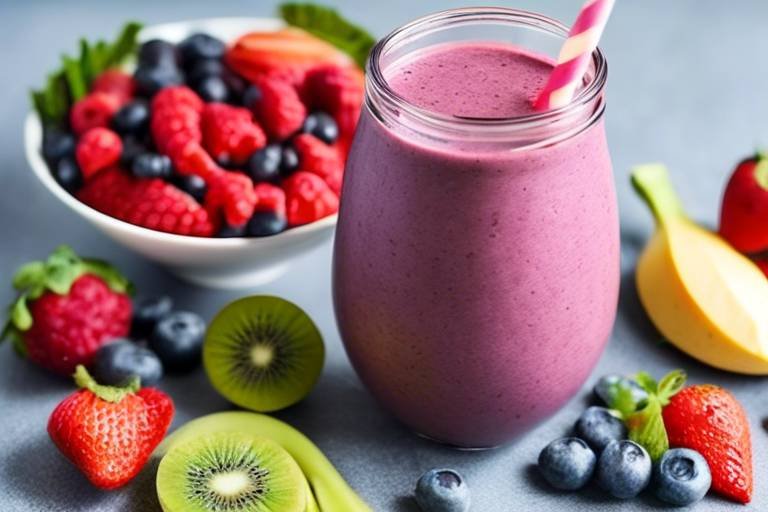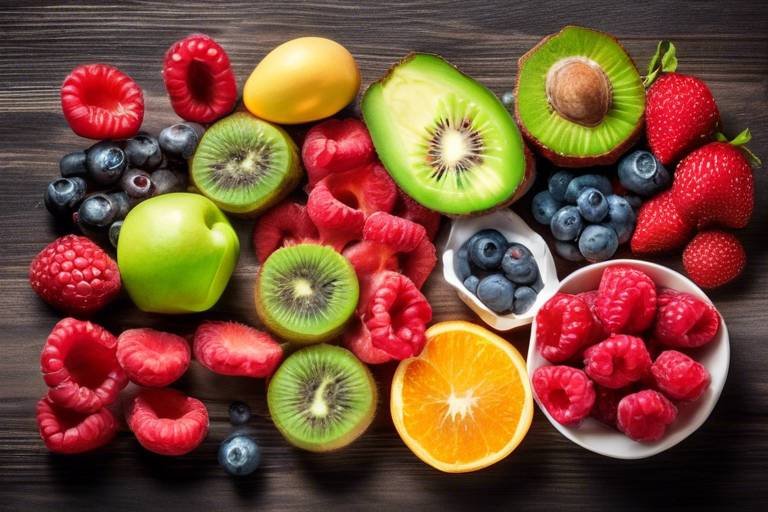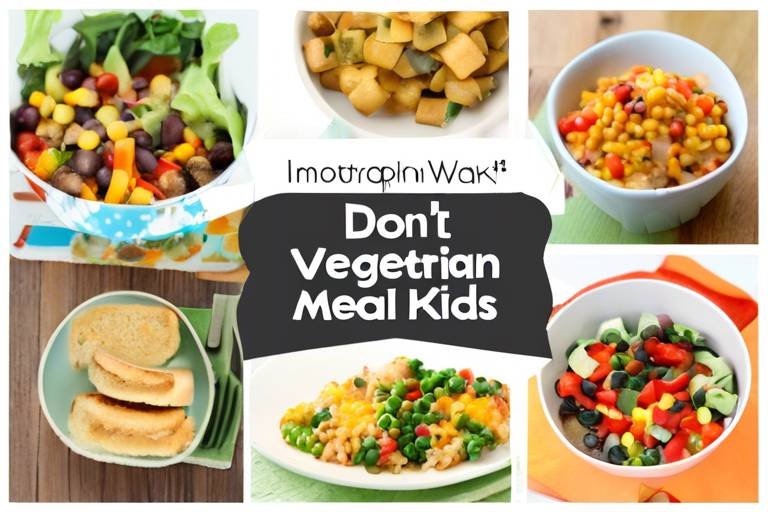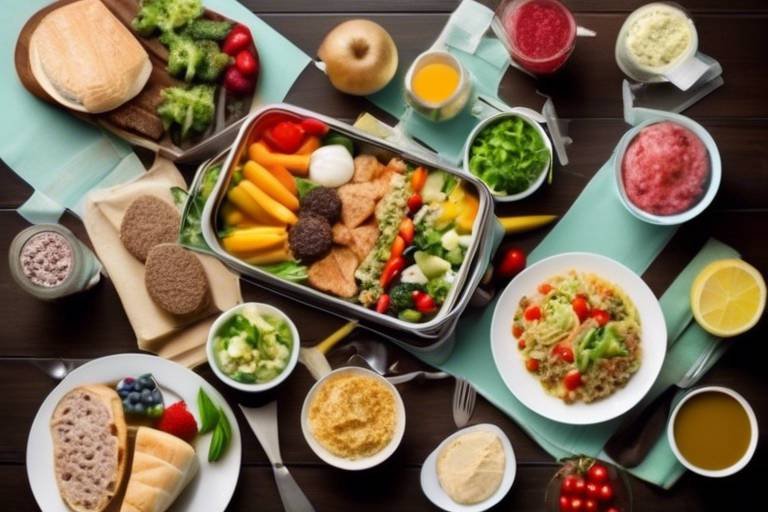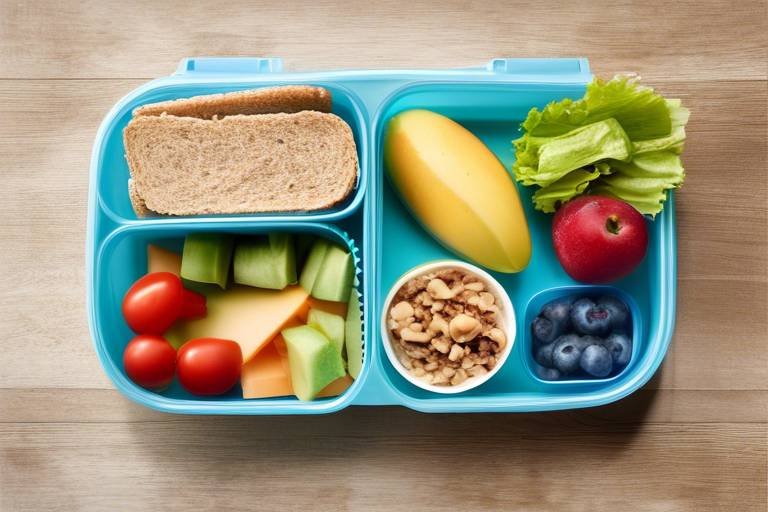Quick Family Meals: How to Beat the Weeknight Rush
In today's fast-paced world, juggling work, school, and extracurricular activities can make family meals feel like an impossible task. But fear not! With a little planning and some clever cooking strategies, you can whip up nutritious and delicious dinners without the stress. Imagine sitting down to a meal that not only satisfies your family’s taste buds but also brings everyone together after a long day. Sounds dreamy, right? Well, it’s absolutely achievable! This article will guide you through efficient meal planning and preparation strategies that will help you conquer the weeknight rush.
Understanding the fundamentals of meal planning can save you a tremendous amount of time and reduce the stress that often comes with figuring out what’s for dinner at the last minute. Start by creating a weekly menu that caters to your family’s tastes and dietary needs. Not sure where to begin? Here’s a simple framework:
- **Choose a theme for each night**: For example, Meatless Mondays, Taco Tuesdays, or Stir-fry Wednesdays.
- **Involve the family**: Ask for input on what everyone wants to eat to ensure there are no complaints at the dinner table.
- **Make a shopping list**: Once you’ve decided on the meals, jot down all the ingredients you’ll need to avoid those last-minute grocery runs.
By sticking to a plan, you’ll not only save time but also reduce food waste, as you’ll be more intentional about what you buy and cook.
Let’s face it, cooking can be a time-consuming endeavor. However, by employing some time-saving cooking techniques, you can significantly reduce your meal prep time. Techniques such as one-pot meals and sheet pan dinners are perfect for busy weeknights. Imagine throwing everything into one pot or pan and letting it do its magic while you tackle other tasks. Not only does this streamline your cooking process, but it also simplifies cleanup!
One of the best ways to save time during the week is through batch cooking. This method allows you to prepare large quantities of food in advance, ensuring that you have meals ready to go when you need them. Think of it as cooking once and eating multiple times! Here are some benefits and strategies:
- **Less stress during the week**: With meals prepped, you can simply heat and serve.
- **Variety**: Cook different meals in one go, so you don’t get bored with leftovers.
- **Save money**: Buying ingredients in bulk often saves you cash.
Another fantastic strategy is to focus on freezer-friendly meals. These are dishes that can be made in bulk and frozen for later use. Think of soups, stews, casseroles, and even marinated proteins. Here’s a quick guide on what to freeze:
| Meal Type | Freezing Tips |
|---|---|
| Soups & Stews | Cool completely before transferring to airtight containers. |
| Casseroles | Assemble but do not bake; cover tightly and freeze. |
| Marinated Proteins | Freeze in marinade; thaw overnight in the fridge before cooking. |
Proper storage is key, so make sure to label everything with the date and contents to avoid any freezer surprises!
Another way to speed up weeknight cooking is by preparing ingredients ahead of time. Pre-chopping vegetables or marinating proteins can enhance flavor and convenience. For instance, you could spend a little time on Sunday chopping onions, bell peppers, and carrots, so they’re ready to toss into a stir-fry on a hectic Tuesday evening. It’s all about making your life easier!
Now that you have your planning and prepping down, let’s dive into some quick recipes that can be made in 30 minutes or less. These meals are not only fast but also designed to satisfy even the pickiest eaters. Think of dishes like:
- 30-Minute Pasta Primavera: Fresh veggies tossed with pasta and a light sauce.
- Sheet Pan Chicken Fajitas: Everything cooks together for maximum flavor with minimal effort.
- Stir-Fried Rice: Use leftover rice and whatever veggies you have on hand for a quick meal.
Cooking doesn’t have to be a solo mission! Getting the whole family involved can make meal preparation more enjoyable. Assign tasks based on age and skill level. For example, younger kids can wash vegetables while older ones can handle chopping. This not only lightens your load but also teaches valuable skills.
Engaging children in cooking fosters a love for food and teaches them important life skills. Think of it as a fun family bonding activity! Here are some age-appropriate tasks:
- Toddlers: Washing produce and stirring ingredients.
- Preschoolers: Assembling mini pizzas or making sandwiches.
- Older Kids: Chopping vegetables and following simple recipes.
Establishing family meal traditions can enhance bonding and create lasting memories. Consider themed dinners, such as Italian Night or Taco Tuesday, where everyone can contribute. These special occasions not only make meals more exciting but also bring everyone together around the table, fostering connection and conversation.
Q: How can I make meal planning easier?
A: Start simple! Choose a few favorite meals and rotate them weekly. Use apps or planners to keep track.
Q: What are some quick meal ideas for busy weeknights?
A: Think one-pot meals, sheet pan dinners, or quick stir-fries that can be ready in 30 minutes!
Q: Can I involve my kids in meal prep?
A: Absolutely! Assign age-appropriate tasks to make cooking a fun family activity.

Meal Planning Basics
Understanding the fundamentals of meal planning can be a game changer for busy families. Imagine coming home after a long day and knowing exactly what’s for dinner without the stress of last-minute decisions. Meal planning is all about making your life easier and your meals more enjoyable. By taking a little time to plan your week, you can ensure that your family eats nutritious, delicious meals without the chaos that often accompanies weeknight cooking.
To get started, it's essential to consider your family’s tastes and dietary needs. Everyone has different preferences, and meal planning should reflect that. Sit down with your family and discuss their favorite meals. This not only helps you create a menu that everyone will enjoy but also involves them in the process, making it more fun! You can use a simple template to draft your weekly menu:
| Day | Meal | Notes |
|---|---|---|
| Monday | Taco Night | Use leftover chicken from Sunday |
| Tuesday | Pasta Primavera | Incorporate seasonal vegetables |
| Wednesday | Sheet Pan Salmon | Quick and healthy |
| Thursday | Stir-Fried Rice | Use leftover veggies |
| Friday | Pizza Night | Make your own with family |
Once you have your menu, it’s time to create a shopping list. This is where the magic happens! A well-organized shopping list not only saves you time at the grocery store but also helps you avoid impulse buys. Group your items by category—fruits, vegetables, dairy, etc.—to make your shopping trip as efficient as possible. Plus, when you have everything you need on hand, it’s much easier to stick to your meal plan.
Another key aspect of meal planning is flexibility. Life happens, and sometimes you may need to swap out meals or adjust your plans. That’s perfectly okay! Having a few backup meals that you can whip up quickly can alleviate stress. Think of meals that require minimal ingredients or can be prepared in under 30 minutes. This way, you’re never left scrambling for dinner ideas.
Finally, don’t forget to involve the whole family in the meal planning process. Whether it’s choosing meals, helping with grocery shopping, or even cooking, getting everyone on board can make the experience more enjoyable. Plus, it teaches kids valuable skills and encourages them to try new foods. Remember, the goal is to create a positive atmosphere around meal times that fosters connection and enjoyment.
In conclusion, meal planning doesn’t have to be complicated. By understanding your family’s needs, organizing your menu, and staying flexible, you can turn weeknight dinners from a stressful chore into a delightful family experience. So why not give it a try? You might just discover that planning your meals is the secret ingredient to a happier, healthier family life!

Time-Saving Cooking Techniques
In the hustle and bustle of daily life, finding time to prepare nutritious meals can sometimes feel like an uphill battle. But fear not! By mastering a few , you can transform your weeknight dinners from chaotic to calm. Imagine being able to whip up a delicious meal in a fraction of the time it usually takes. Sounds like magic, right? Well, it’s all about smart strategies that streamline your cooking process and make cleanup a breeze.
One of the most effective methods is the art of one-pot meals. These dishes not only save time by cooking everything in a single pot or pan, but they also minimize the number of dishes you have to wash afterward. Think of hearty stews, pasta dishes, or stir-fries where all the ingredients come together in a harmonious blend of flavors. Not only does this technique cut down on prep time, but it also allows the ingredients to marinate in their own juices, enhancing the overall taste.
Another fantastic time-saving approach is the sheet pan dinner. This method involves tossing your favorite proteins and vegetables onto a single baking sheet, seasoning them, and letting the oven do the work. Imagine the aroma wafting through your home as everything cooks together, creating a meal that’s both tasty and visually appealing. Plus, cleanup is a snap—just line the sheet with parchment paper, and you’re golden!
Now, let’s talk about batch cooking. This technique is like having a secret weapon in your culinary arsenal. By preparing large quantities of food in advance, you set yourself up for success during the hectic week ahead. For instance, you could dedicate a few hours on the weekend to cook a big pot of chili, a tray of roasted vegetables, or a batch of quinoa. These staples can be easily mixed and matched throughout the week to create a variety of meals. You’ll not only save time but also reduce the temptation to reach for unhealthy takeout options.
Speaking of batch cooking, let’s dive into freezer-friendly meals. Freezing meals is a game-changer when it comes to quick weeknight dinners. Some dishes freeze exceptionally well, allowing you to prepare them ahead of time and simply reheat when hunger strikes. Consider making lasagna, soups, or casseroles that can be portioned out and stored in airtight containers. When you’re ready to eat, just pop them in the oven or microwave. It’s like having a homemade meal on standby!
To ensure your meals maintain their quality, here are some essential tips:
| Meal Type | Freezing Tips |
|---|---|
| Soups & Stews | Cool completely before transferring to freezer-safe containers. |
| Casseroles | Wrap tightly in foil or plastic wrap to prevent freezer burn. |
| Cooked Grains | Portion into bags for easy reheating. |
Another strategy to streamline your weeknight cooking is to prepare ingredients ahead of time. Think about chopping vegetables, marinating proteins, or even cooking grains in advance. By having these components ready to go, you can cut down on the time it takes to get dinner on the table. Imagine coming home after a long day and finding prepped ingredients waiting for you. It’s like having a personal sous chef at your disposal!
Consider setting aside some time on Sunday to chop up a variety of vegetables. You can store them in airtight containers in the fridge, making it easy to toss them into any dish throughout the week. Marinating proteins the night before can also enhance flavors and save you precious minutes when it’s time to cook.
By incorporating these into your routine, you'll not only reclaim your evenings but also enjoy delicious, home-cooked meals that bring your family together. So, roll up your sleeves, get creative, and watch how these strategies transform your weeknight dinners!
Q: What is batch cooking?
A: Batch cooking involves preparing large quantities of food at once, which can then be stored and eaten throughout the week. It helps save time and ensures you have healthy meals ready to go.
Q: Can all meals be frozen?
A: Not all meals freeze well, but soups, stews, casseroles, and cooked grains typically do. It's important to cool them completely and store them in airtight containers to maintain quality.
Q: How can I involve my kids in cooking?
A: Assign age-appropriate tasks, like washing vegetables, stirring ingredients, or setting the table. This not only teaches them valuable skills but also makes cooking a fun family activity.

Batch Cooking
Batch cooking is like having your cake and eating it too—preparing meals in advance not only saves you time during the busy week but also ensures that you have nutritious options readily available. Imagine coming home after a long day, and instead of scrambling to whip up dinner, you can simply heat up a delicious homemade meal. Sounds dreamy, right? The concept is simple: cook large quantities of food at once and store them for later use. This method is a lifesaver for families juggling hectic schedules, and it can also help you stick to a healthier diet.
One of the key benefits of batch cooking is the time efficiency it offers. By dedicating just a few hours on the weekend or your day off, you can prepare several meals that will last you throughout the week. Not only does this save you from the daily grind of cooking, but it also reduces the temptation to order takeout or eat unhealthy snacks. You can think of it as setting up a 'meal factory' in your kitchen where the assembly line is all about delicious and wholesome food.
When you batch cook, consider meals that are versatile and can be easily reheated or repurposed. For instance, a big pot of chili can be enjoyed on its own, served over rice, or even used as a topping for baked potatoes. This flexibility allows you to keep things interesting throughout the week. Here are some popular batch cooking ideas:
- Soups and stews: These freeze well and can be made in large quantities.
- Casseroles: A hearty dish that can be portioned out and reheated easily.
- Grains: Cook a big batch of quinoa or rice to use as a base for multiple meals.
- Proteins: Grill or bake chicken breasts, tofu, or fish in bulk to add to various dishes.
To get started with batch cooking, you’ll want to plan your meals for the week. Choose recipes that share similar ingredients to minimize waste and maximize efficiency. For example, if you're making a stir-fry, you might also use the same vegetables in a soup or salad later in the week. This not only saves time but also keeps your grocery shopping streamlined.
Once you’ve chosen your recipes, gather your ingredients and set aside a few hours to cook. It’s helpful to have good quality storage containers on hand—think glass or BPA-free plastic that can go from the freezer to the microwave. Label each container with the meal name and date to keep track of freshness. When it’s time to eat, simply pull a meal from the freezer, reheat, and enjoy!
In summary, batch cooking is a fantastic strategy for busy families. By dedicating time to prepare meals in advance, you can enjoy home-cooked food without the daily hassle. It’s like having a secret weapon against weeknight stress, ensuring that you can nourish your family without sacrificing precious time.
Q: How long can I store batch-cooked meals in the freezer?
A: Most cooked meals can be stored in the freezer for up to 3 months. Be sure to label them with the date and name to keep track.
Q: Can I batch cook for special diets?
A: Absolutely! Just choose recipes that align with dietary needs, such as gluten-free, vegetarian, or low-carb, and prepare them in larger quantities.
Q: What are some easy batch-cooking recipes?
A: Some popular options include chili, vegetable soup, casseroles, and stir-fried grains with proteins. These dishes are simple to make and reheat well.
Q: How can I make sure my batch-cooked meals remain flavorful?
A: Use herbs, spices, and marinades to enhance the flavor of your meals. Additionally, consider adding fresh ingredients like herbs just before serving to brighten up the dish.

Freezer-Friendly Meals
When it comes to busy weeknights, having on hand can be a game changer. Imagine coming home after a long day and knowing that a delicious, homemade dinner is just a few minutes away from being on the table. By preparing meals in advance and storing them in the freezer, you can eliminate the stress of last-minute cooking and ensure that your family enjoys nutritious options every night. But what exactly makes a meal suitable for freezing? Let's dive into the essentials!
First, it's important to understand that not all meals freeze well. Generally, dishes that contain high moisture content, such as soups and stews, are excellent candidates for freezing. Additionally, meals that can be easily portioned, like casseroles and pasta dishes, also work beautifully. Here’s a quick overview of some popular freezer-friendly meals:
| Meal Type | Freezing Tips | Storage Duration |
|---|---|---|
| Soups & Stews | Cool completely before transferring to airtight containers. | Up to 3 months |
| Casseroles | Wrap tightly in foil or plastic wrap before freezing. | Up to 2 months |
| Pasta Dishes | Under-cook pasta slightly for best results. | Up to 3 months |
| Meatballs | Flash freeze on a baking sheet before transferring to bags. | Up to 4 months |
Now that you know which types of meals freeze well, let’s talk about proper storage. The key to maintaining the quality of your frozen meals lies in how you package them. Always use airtight containers or heavy-duty freezer bags to prevent freezer burn. It’s also a good idea to label your meals with the date and contents, so you can easily find what you’re looking for during the week.
Another great strategy is to prepare freezer-friendly ingredients. For instance, you can chop vegetables in bulk and freeze them in portion-sized bags. This not only saves time but also ensures that you have fresh ingredients ready to go. Similarly, marinating proteins like chicken or beef and then freezing them can enhance flavor while giving you a head start on meal prep.
Incorporating freezer-friendly meals into your weekly routine can significantly reduce the chaos of weeknight dinners. By investing a little time upfront to prepare and store these meals, you'll find that your evenings become more relaxed and enjoyable. Plus, your family will appreciate the effort you put into providing them with healthy, home-cooked meals that are ready in a flash!

Make-Ahead Ingredients
In the whirlwind of busy weeknights, the last thing you want to do is spend hours in the kitchen. That’s where come into play, revolutionizing your cooking routine and making dinner a breeze. Imagine coming home after a long day and only needing to assemble a few prepped items to whip up a delicious meal. Sounds dreamy, right? Well, it can be your reality with just a bit of planning!
Start by dedicating a few hours on the weekend to prepare ingredients that can be stored and used throughout the week. Think of it as setting up your own culinary assembly line! Some fantastic make-ahead ingredients include:
- Chopped Vegetables: Slice and dice your favorite veggies such as bell peppers, onions, and carrots. Store them in airtight containers in the fridge, and they’ll be ready to toss into stir-fries, salads, or soups.
- Marinated Proteins: Marinating chicken, beef, or tofu not only adds flavor but also tenderizes the meat. Prepare marinades in advance and let your proteins soak up the goodness overnight, so they’re ready to be grilled or baked when you need them.
- Pre-cooked Grains: Cook a big batch of quinoa, rice, or pasta and store it in the fridge. They make a fantastic base for salads, bowls, or as sides to your main dishes.
Additionally, consider preparing sauces and dressings ahead of time. A homemade vinaigrette or a zesty salsa can elevate any dish and can be stored in the fridge for several days. Just imagine how much time you’ll save by having these essentials ready to go!
When it comes to storage, use clear containers so you can easily see what you have on hand. Labeling them with the date can also help keep track of freshness. This way, you won't be rummaging through your fridge, wondering what’s still good to use. Plus, it adds a touch of organization to your kitchen, making cooking feel less chaotic.
By incorporating make-ahead ingredients into your meal prep routine, you’re not just saving time; you’re also creating a more enjoyable cooking experience. You’ll find that having everything prepped and ready allows you to focus on the joy of cooking and spending time with your family rather than stressing about what to make for dinner. So, roll up your sleeves, get chopping, and unlock the secret to stress-free weeknight dinners!
Q: How long can I store make-ahead ingredients in the fridge?
A: Most chopped vegetables can last about 3-5 days in the fridge, while marinated proteins can be stored for up to 2 days. Cooked grains typically last about a week. Always check for freshness before using!
Q: Can I freeze make-ahead ingredients?
A: Absolutely! Many make-ahead ingredients freeze well, such as cooked grains, marinated proteins, and even some chopped vegetables. Just be sure to store them in airtight containers to prevent freezer burn.
Q: What are some quick meals I can make with prepped ingredients?
A: With prepped ingredients, you can whip up stir-fries, grain bowls, salads, or quick pasta dishes in no time. Just combine your prepped items, add a sauce or seasoning, and you’re good to go!

Quick Recipes for Busy Nights
When the clock is ticking and the kids are hungry, the last thing you want is to be stuck in the kitchen for hours. Luckily, there are plenty of quick recipes that can help you whip up a delicious dinner in no time! Imagine this: you walk in the door after a long day, and within 30 minutes, you’re sitting down to a meal that everyone loves. Sounds like a dream, right? Let’s turn that dream into reality with some easy-to-follow recipes that are as tasty as they are fast!
First up, let’s talk about the classic stir-fry. This dish is not only quick but also incredibly versatile. You can use whatever vegetables you have on hand, toss in some protein like chicken, beef, or tofu, and finish it off with a flavorful sauce. Here’s a simple method:
- Ingredients: 1 lb protein, 4 cups mixed veggies, 2 tbsp soy sauce, 1 tbsp sesame oil.
- Instructions: Heat sesame oil in a pan, add protein until cooked, toss in veggies, stir in soy sauce, and cook for another 5 minutes. Serve over rice or noodles!
Next, let’s dive into the world of sheet pan dinners. These are a game changer for busy nights! You simply throw your ingredients onto a baking sheet, season them, and let the oven do the work. Think roasted chicken thighs with sweet potatoes and broccoli. Just chop everything, season with olive oil, salt, and pepper, and bake at 425°F for about 25-30 minutes. It’s minimal effort and maximum flavor!
If you’re in the mood for something a bit different, consider making tacos. They’re quick to assemble, and you can customize them to fit everyone’s tastes. Start with a protein base, like ground beef or shredded chicken, and let everyone build their own tacos with toppings like lettuce, cheese, salsa, and avocado. This not only saves time but also makes dinner interactive and fun!
For those nights when you need something super speedy, try a pasta dish. A simple garlic and olive oil spaghetti can be ready in under 15 minutes. Just boil your pasta, sauté garlic in olive oil, toss in the pasta, and finish with a sprinkle of parmesan cheese and fresh herbs. It’s a light, satisfying meal that feels fancy but is incredibly easy to prepare!
Lastly, don’t underestimate the power of a good soup. A hearty vegetable or chicken soup can be made in just 20 minutes if you have pre-chopped ingredients. Just sauté your base (onions, garlic), add broth and your choice of veggies or proteins, and let it simmer. Serve with crusty bread for a complete meal that’s both comforting and quick!
In summary, the key to quick family meals is having a few go-to recipes that you can prepare in a flash. By incorporating simple techniques like stir-frying, sheet pan dinners, and customizable options like tacos, you can ensure that even the busiest nights can end with a delicious, home-cooked meal. So, roll up your sleeves and get cooking—your family will thank you!
Q: How can I make meal prep easier during the week?
A: Consider dedicating a couple of hours on the weekend to chop vegetables, marinate proteins, and prepare sauces. This will save you time on busy weeknights!
Q: What are some freezer-friendly meals?
A: Some great options include chili, lasagna, and soups. Just make sure to store them in airtight containers to maintain freshness.
Q: How can I get my kids involved in cooking?
A: Assign age-appropriate tasks, like washing vegetables, stirring ingredients, or setting the table. It makes cooking a fun family activity!

Involving the Family
Cooking can often feel like a chore, especially on those hectic weeknights when everyone seems to be rushing from one activity to another. However, in meal preparation can transform this daunting task into a fun and engaging experience. Imagine the laughter and teamwork that can unfold in your kitchen when everyone pitches in! Not only does it lighten the load for you, but it also fosters a sense of togetherness that can be hard to find in our busy lives.
One of the best ways to get everyone involved is by assigning specific tasks based on age and skill level. For instance, younger kids can wash vegetables or set the table, while older children can help with chopping or stirring. This not only teaches them valuable cooking skills but also instills a sense of responsibility and accomplishment. You might even be surprised at how much they enjoy it! Plus, cooking together can lead to some pretty hilarious moments, like when someone accidentally drops a spoonful of flour all over the floor.
Incorporating family traditions into your cooking routine can also enhance the experience. Consider having a designated night each week for a themed dinner where everyone contributes a dish. For example, you could have Taco Tuesdays where everyone can customize their own tacos, or Pasta Night where each family member selects their favorite sauce. This not only makes meal prep easier but also gives everyone something to look forward to. The anticipation of these meals can create excitement and a sense of belonging that is hard to replicate.
Furthermore, cooking together can be a great opportunity to teach kids about nutrition and the importance of healthy eating. Discussing the ingredients you’re using and their benefits can spark curiosity and encourage them to try new foods. You might say, “Did you know that carrots are great for your eyesight?” This not only makes them more likely to eat their veggies but also empowers them to make healthier choices in the future.
Lastly, don’t forget to capture these moments! Take photos of your family cooking together, and maybe even start a family recipe book that includes everyone’s favorite dishes. This can become a cherished keepsake that celebrates your family’s culinary adventures. Involving the family in meal preparation not only makes cooking more enjoyable but also creates lasting memories that everyone will treasure.
- How can I get my kids interested in cooking?
Start with simple recipes that allow them to be hands-on and gradually introduce more complex tasks as they gain confidence. - What age is appropriate for kids to help in the kitchen?
Children as young as 2-3 can help with washing vegetables, while older kids can assist with chopping and cooking. - How can we make cooking a family tradition?
Choose a specific night each week for family cooking, incorporate themed meals, and encourage everyone to contribute their favorite recipes.

Cooking with Kids
Engaging your kids in the kitchen can be a fantastic way to bond while teaching them essential life skills. Cooking together not only helps them understand the value of nutrition but also fosters creativity and confidence. Imagine the joy on their faces as they stir, sprinkle, and taste their creations! So, how can you make cooking with kids an enjoyable experience? Here are a few tips to get you started.
First off, it’s important to choose recipes that are simple and fun. Think about meals that allow for hands-on participation. Dishes like homemade pizzas, where they can spread sauce and sprinkle toppings, or colorful fruit salads, where they can chop (with supervision, of course) and mix, are perfect for little chefs. Not only are these recipes easy to follow, but they also encourage kids to explore different flavors and textures. Plus, they get to enjoy the delicious results!
When it comes to involving kids, assigning age-appropriate tasks is key. Younger children can help with washing vegetables, stirring ingredients, or measuring out dry goods. As they grow older, you can gradually introduce them to more complex tasks like chopping (using kid-safe knives), sautéing, or even handling the oven with your guidance. This progression not only builds their confidence but also allows them to feel like they are contributing to the family meal.
To keep things organized and fun, try creating a mini cooking schedule. This can be a simple chart that outlines what meals you’ll be preparing together throughout the week. Not only does this keep everyone on the same page, but it also gives your kids something to look forward to. You could even let them choose a meal each week, empowering them to take ownership of their culinary experiences.
Of course, cooking with kids is not just about the food; it's about creating memories. Consider setting the mood with some music or even themed cooking nights. For instance, you could have “Taco Tuesdays” where everyone gets to assemble their own tacos, or “Pasta Night” where everyone can choose their favorite pasta and sauce combinations. These traditions can turn cooking into a delightful family event rather than just another chore.
Lastly, don’t forget to celebrate your culinary adventures! Whether it’s taking photos of your creations, having a taste test, or even hosting a mini family dinner where everyone showcases their dishes, these moments will become cherished memories. Remember, the goal is to make cooking a joyous experience, so embrace the messiness and creativity that comes with it!
Q: What age can my child start cooking with me?
A: Children can start helping in the kitchen as early as 2-3 years old with simple tasks like washing vegetables or mixing ingredients. As they grow older, you can introduce more complex tasks.
Q: How can I ensure safety while cooking with kids?
A: Always supervise your children closely, use kid-safe utensils, and teach them about kitchen safety rules, such as not touching hot surfaces or sharp knives.
Q: What are some easy recipes to start with?
A: Some great beginner recipes include homemade pizzas, fruit salads, smoothies, and pancakes. These dishes allow for creativity and are simple enough for kids to help with.
Q: How can I keep my kids engaged during cooking?
A: Make it fun by letting them choose recipes, create a cooking schedule, and incorporate themes or music. Celebrating your cooking successes together can also keep their interest alive!

Family Meal Traditions
Establishing is more than just a way to enjoy food together; it’s a chance to create lasting memories and strengthen family bonds. Think about it: how many times have you gathered around the dinner table, sharing stories and laughter? These moments are priceless, and they often stem from traditions that you can create and nurture over time.
One of the simplest ways to start a tradition is to choose a specific day of the week for a family dinner. Picture this: every Sunday evening, the family comes together to cook a special meal. You could rotate who picks the recipe, allowing everyone to share their favorites. This not only makes each dinner unique but also encourages everyone to explore different cuisines and flavors. It’s like a mini culinary adventure right in your kitchen!
Another fun idea is to establish themed dinners. Whether it’s “Taco Tuesday,” “Pasta Night,” or “Breakfast for Dinner,” these themes can add a splash of excitement to your week. You could even create a family recipe book where everyone contributes their favorite dishes, making it a cherished keepsake. Imagine flipping through those pages years later, reminiscing about the meals you shared and the stories that accompanied them.
Don’t forget the power of special occasions! Birthdays, anniversaries, or even just the first day of school can become opportunities for family feasts. You could make it a tradition to cook a favorite dish of the person being celebrated. This not only honors them but also brings everyone together to enjoy the fruits of their labor. And let’s be honest, who doesn’t love a good excuse to indulge in delicious food?
As you cultivate these traditions, consider involving everyone in the cooking process. Assign different roles based on age and skill level. Kids can help with washing vegetables or setting the table, while older family members can take on more complex tasks. This teamwork fosters a sense of community and teaches valuable cooking skills that kids will carry with them into adulthood.
In the end, the goal is to make mealtime a cherished part of your family’s routine. These traditions not only enhance the dining experience but also create a sense of belonging. So, gather your loved ones, share a meal, and create those unforgettable moments that will be talked about for years to come!
- How can I start a family meal tradition? Begin by choosing a specific day for family dinners, and involve everyone in the planning and cooking process.
- What are some good themes for family dinners? You can try Taco Tuesday, Pasta Night, or even Breakfast for Dinner to keep things exciting.
- How can I involve my kids in cooking? Assign age-appropriate tasks, such as washing vegetables or measuring ingredients, to make cooking a fun family activity.
- What if my family has different dietary needs? Choose recipes that can be easily adapted to cater to everyone’s preferences, ensuring that all family members can enjoy the meal.
Frequently Asked Questions
- What is meal planning and why is it important?
Meal planning is the process of planning your meals for the week ahead. It’s important because it saves you time, reduces stress, and helps you stick to a budget. By knowing what you’ll eat each day, you can avoid last-minute takeout and ensure your family enjoys nutritious meals.
- How can I get my family involved in meal preparation?
Involving your family in meal prep can be a fun way to bond! Assign age-appropriate tasks, like washing vegetables or stirring sauces. Encourage teamwork by making it a game or setting a timer to see how quickly you can prepare a dish together. This not only makes cooking more enjoyable but also teaches valuable skills.
- What are some quick recipes I can make for busy weeknights?
There are plenty of quick recipes that can be made in 30 minutes or less! Think of one-pot pasta dishes, stir-fries, or sheet pan dinners that combine protein and veggies. These meals are not only fast to prepare but also minimize cleanup, making them perfect for hectic evenings.
- What is batch cooking and how can it help me?
Batch cooking involves preparing large quantities of food at once, which can be a game-changer for busy families. By cooking in bulk, you can have meals ready to go throughout the week, saving time on cooking and cleanup. It’s a great way to ensure you always have something nutritious on hand.
- Which meals freeze well for later use?
Some meals freeze exceptionally well, such as soups, stews, casseroles, and chili. These dishes can be made in advance and stored in the freezer for quick dinners later on. Just remember to use airtight containers to prevent freezer burn and label them with dates for easy identification.
- How can I prepare ingredients ahead of time?
Preparing ingredients ahead of time can significantly speed up your cooking process. You can chop vegetables, marinate proteins, or even cook grains in advance. Store these prepped ingredients in the fridge so they’re ready to go when you need them, making weeknight cooking a breeze!
- What are some fun family meal traditions I can start?
Starting family meal traditions can create lasting memories! Consider themed dinners, like Taco Tuesdays or Pizza Fridays, where everyone can customize their own meal. You could also have a family potluck where each member brings a dish, fostering creativity and participation from everyone.




